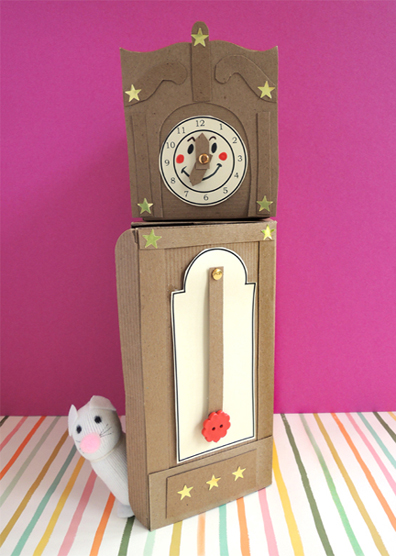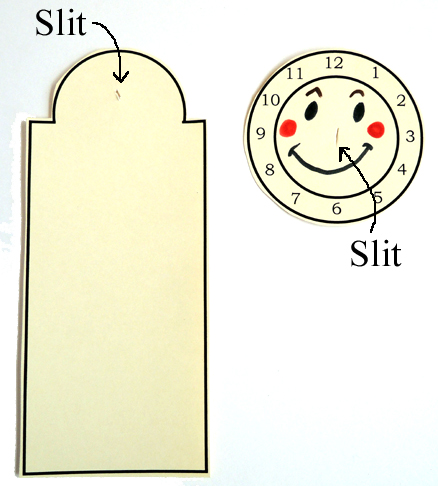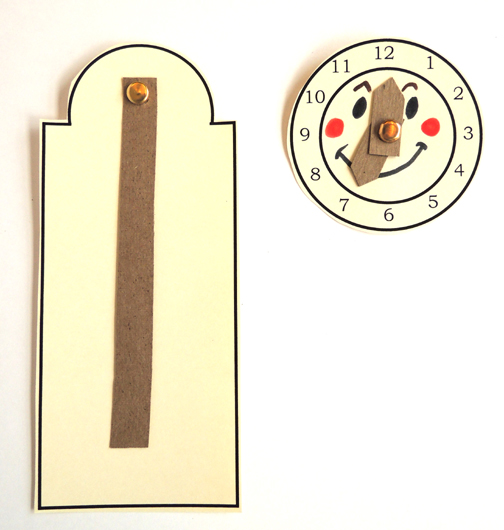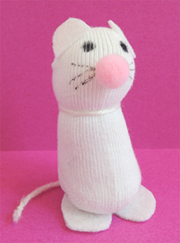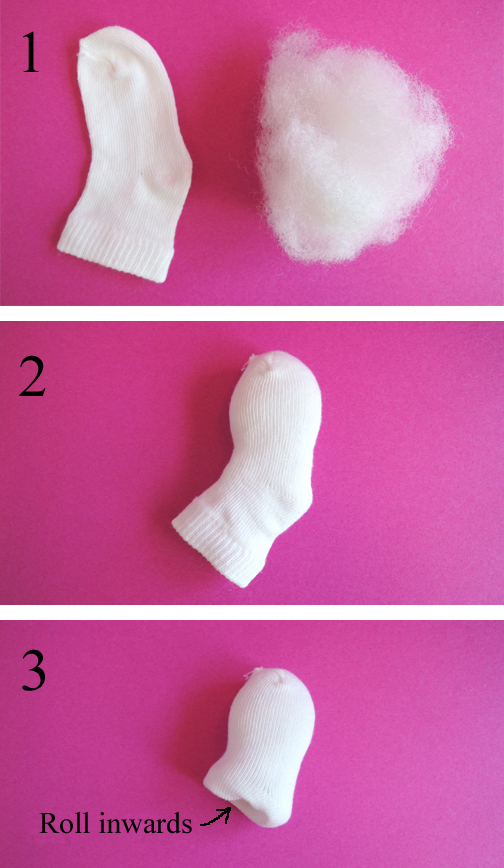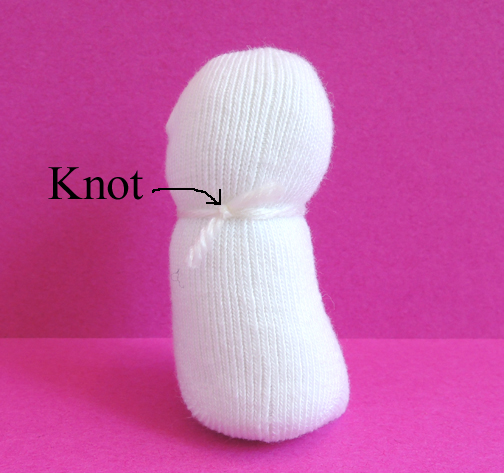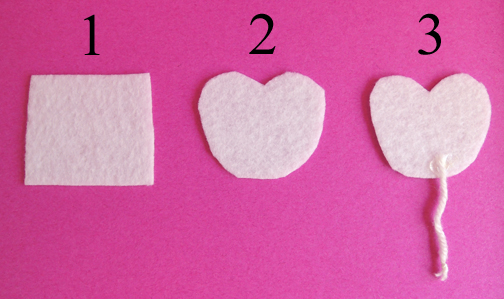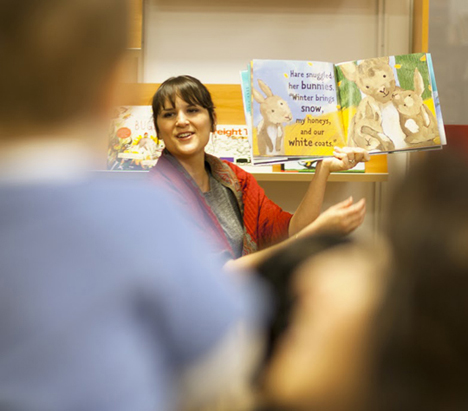 If you happen to be on Greene Street, on New York University’s campus, on just the right day, you might notice a parade of strollers and eager children piling into an inconspicuous brown brick building. There, on the 5th floor, is a beautiful little gem of a children’s library – the Constantine Georgiou Library and Resource Center for Children and Literature.
If you happen to be on Greene Street, on New York University’s campus, on just the right day, you might notice a parade of strollers and eager children piling into an inconspicuous brown brick building. There, on the 5th floor, is a beautiful little gem of a children’s library – the Constantine Georgiou Library and Resource Center for Children and Literature.
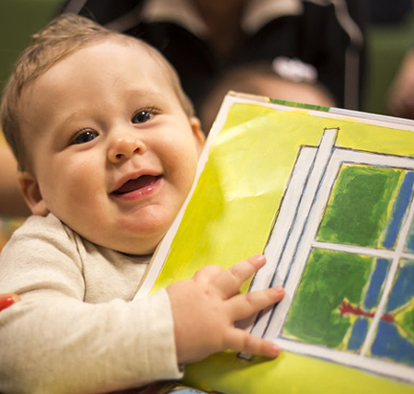 The library honors author, scholar, and late NYU Steinhardt professor Constantine Georgiou (you might recognize one of his books, The Clock, from this story time post). It houses, and continues to grow, Georgiou’s children’s literature collection, and is the home to NYU’s Clinical Literacy Practicum, which offers intensive tutoring for grade 1 through high school.
The library honors author, scholar, and late NYU Steinhardt professor Constantine Georgiou (you might recognize one of his books, The Clock, from this story time post). It houses, and continues to grow, Georgiou’s children’s literature collection, and is the home to NYU’s Clinical Literacy Practicum, which offers intensive tutoring for grade 1 through high school.
The library also offers community story times, programs, learning initiatives, innovative collaborations, and panel discussion (check out this one with Kwame Alexander!), which are developed, coordinated, and oft delivered by, super librarian Kendra Tyson.
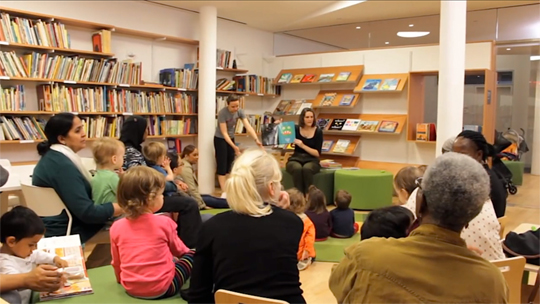 Kendra offers three weekly infant and toddler morning story times. Twice weekly, she heads offsite to local schools to lead emergent literacy programs. Additionally, she hosts student field observations for the Office of Clinical Studies, facilitates events with the Office of Community Affairs, leads professional development workshops, and guest lectures in Teaching & Learning courses at NYU. She’s a busy, busy woman.
Kendra offers three weekly infant and toddler morning story times. Twice weekly, she heads offsite to local schools to lead emergent literacy programs. Additionally, she hosts student field observations for the Office of Clinical Studies, facilitates events with the Office of Community Affairs, leads professional development workshops, and guest lectures in Teaching & Learning courses at NYU. She’s a busy, busy woman.
On a side note (but I have to mention it because it is so awesome) Kendra is launching a collaborative read-aloud program with historic homes, beginning with Sagamore Hill, Teddy Roosevelt’s family home in Long Island. She’s hoping that the pilot program, which merges picture book biographies with objects in the historic home setting, will be the ultimate primary source experience. As I said, awesome.
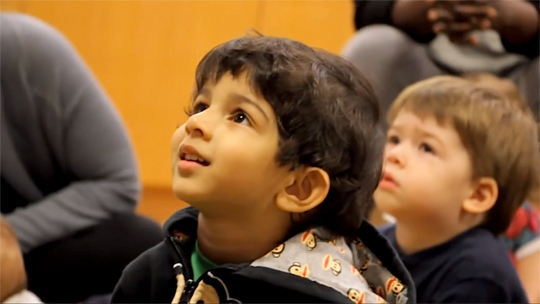
The last time I was in New York City, I stopped by the Constantine Georgiou Library to snap a few pictures of this beautiful, charming space.
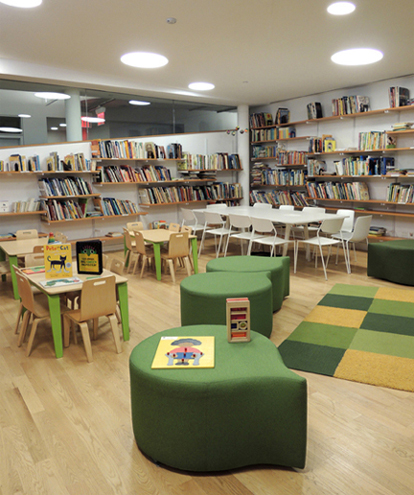 Though it has no windows to the exterior of the building, the room’s high ceilings, ample overhead lighting, and fresh natural and green colors give the little library a feeling of space and light. And check out those big, green, belly-flopping ottomans. Don’t they look like speech bubbles?
Though it has no windows to the exterior of the building, the room’s high ceilings, ample overhead lighting, and fresh natural and green colors give the little library a feeling of space and light. And check out those big, green, belly-flopping ottomans. Don’t they look like speech bubbles?
Running the length of two walls are rows and rows of book shelves. On some, the book are divided into sections of special interest.
 On others, there stacked next to cute little flourishes and kid-friendly props. I especially like this little Egyptian statue with a sepia-tinted world map.
On others, there stacked next to cute little flourishes and kid-friendly props. I especially like this little Egyptian statue with a sepia-tinted world map.
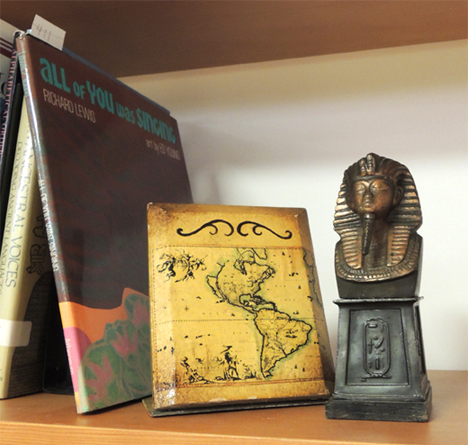 There’s also a section of flat shelves that allow you to display the books by cover. I would love some of these in my library! Nothing says “pick me up!” more than a colorful book cover!
There’s also a section of flat shelves that allow you to display the books by cover. I would love some of these in my library! Nothing says “pick me up!” more than a colorful book cover!
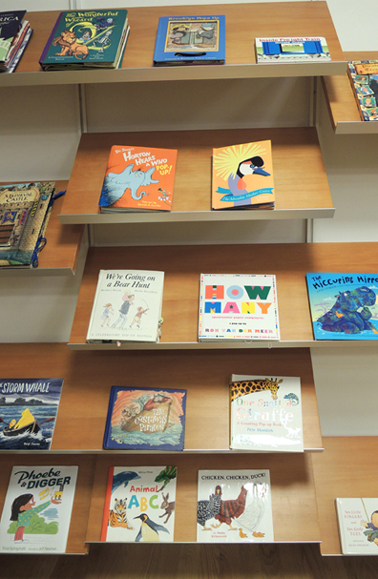 The lower shelves of the library hold the board books, which are stored in clear bins for easy browsing.
The lower shelves of the library hold the board books, which are stored in clear bins for easy browsing.
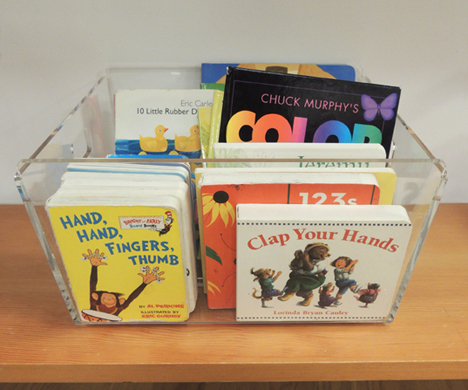 And not too far away from the books are Kendra’s puppets, resting up for their next story time performance.
And not too far away from the books are Kendra’s puppets, resting up for their next story time performance.
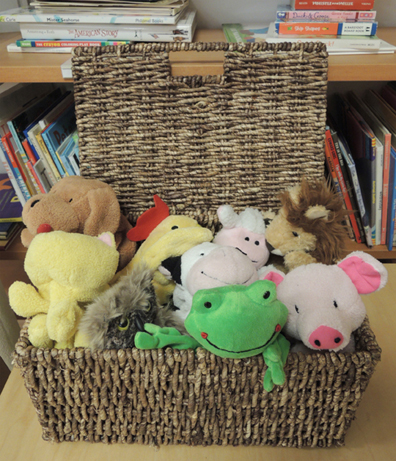 Around the library, kid-size tables (and a few adult ones) are scattered, each holding toys to grab, or books to read!
Around the library, kid-size tables (and a few adult ones) are scattered, each holding toys to grab, or books to read!
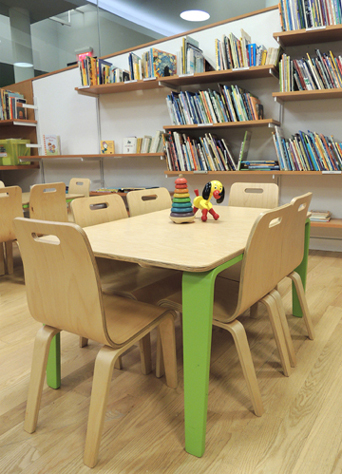

OK, this next photo’s not exactly glamorous, but the practical part of me loved it. The underside of a counter being used for extra chair storage. No ugly stacks of chairs threatening to topple on toddlers here!
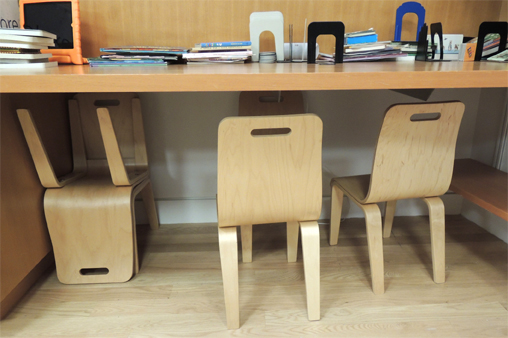 I’m a sucker for cute mobiles (as documented in this post). This airy geometric mobile offered the perfect pop of color in the corner.
I’m a sucker for cute mobiles (as documented in this post). This airy geometric mobile offered the perfect pop of color in the corner.
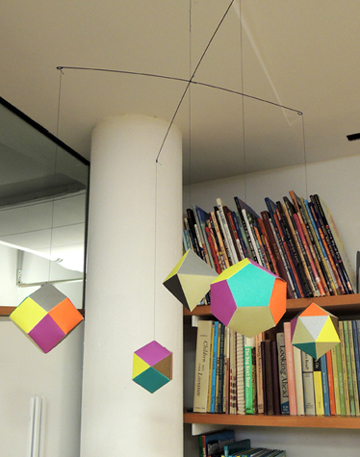 Just outside the main door to the library is an open space for stroller parking, and wooden risers for larger performances or group visitors.
Just outside the main door to the library is an open space for stroller parking, and wooden risers for larger performances or group visitors.
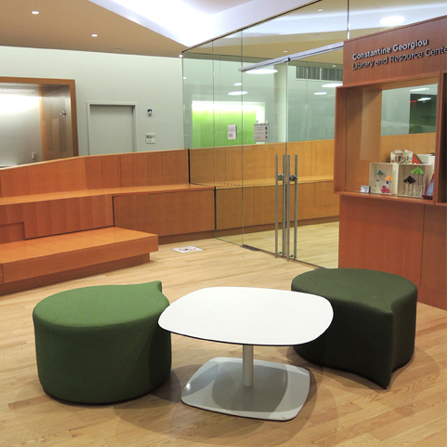 Here’s a closer shot of the front entryway…
Here’s a closer shot of the front entryway…
 Don’t you love the built-in window that doubles as an exhibit space?
Don’t you love the built-in window that doubles as an exhibit space?
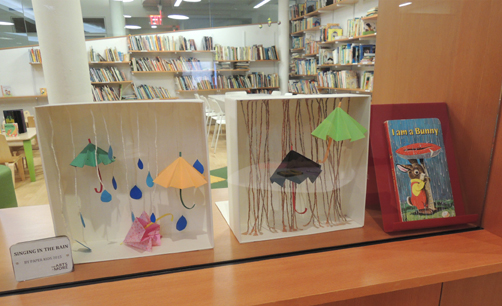 I know New Yorkers have to do clever things with limited space, and this little one-room library is the perfect example of how to be big, spacious, fun, and fresh in a small space. They don’t mind getting messy either! Here’s a shot of a Jackson Pollock-style drip painting program complete with acrylic paints, canvases, paintbrushes, and ping pong balls (as well as read alouds of The Dot (Candlewick, 2003), and Action Jackson (Square Fish, 2007)).
I know New Yorkers have to do clever things with limited space, and this little one-room library is the perfect example of how to be big, spacious, fun, and fresh in a small space. They don’t mind getting messy either! Here’s a shot of a Jackson Pollock-style drip painting program complete with acrylic paints, canvases, paintbrushes, and ping pong balls (as well as read alouds of The Dot (Candlewick, 2003), and Action Jackson (Square Fish, 2007)).
 The Constantine Georgiou Library and Resource Center for Children and Literature is open Monday-Thursdays, 9:00-4:00, and Fridays, 9:00-2:00. If you’re in the area, definitely go for a visit!
The Constantine Georgiou Library and Resource Center for Children and Literature is open Monday-Thursdays, 9:00-4:00, and Fridays, 9:00-2:00. If you’re in the area, definitely go for a visit!
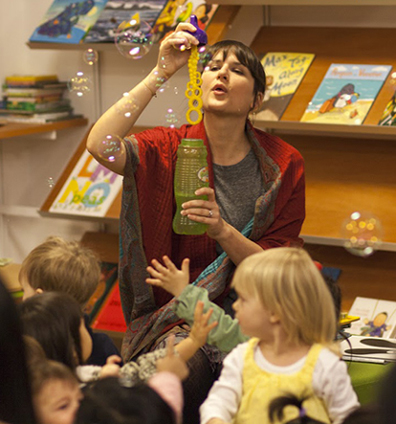
Program images courtesy of the Constantine Georgiou Library and Resource Center for Children and Literature.

